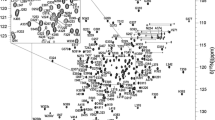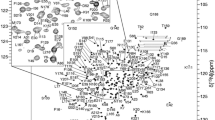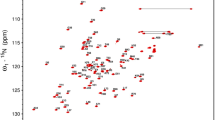Abstract
Clostridium difficile is a gram-positive, toxin-producing, anaerobic bacterium whose virulence factors and mechanisms of pathogenesis require further investigation. C. difficile infections (CDI) result in the severe and potentially fatal gastrointestinal diseases pseudomembranous colitis and toxic megacolon following extensive broad spectrum antibiotic treatment. The increasing C. difficile fatalities are a result of the bacteria’s growing antibiotic resistance and consequential CDI recurrence, which led to the unmet need for new CDI treatment. Bacterial protein synthesis is an essential metabolic process and an effective target for antibacterial agents. Translation initiation factor 1 from C. difficile (Cd-IF1) is the smallest of the three initiation factors that acts to establish the 30S initiation complex to initiate translation during protein biosynthesis. Here we report the complete NMR 1H, 13C and 15N chemical shift assignments of Cd-IF1 as the basis for NMR structure determination and interaction studies. Secondary structure analyses have identified five β-strands and one short α-helix arranged in the sequential order β1-β2-β3-α1-β4-β5, which is supported by 15N-{1H} heteroNOEs. The assigned chemical shifts were used to conduct structure prediction by CS-Rosetta. The predicted structure suggests that Cd-IF1 adopts the typical β-barrel structure and is composed of an oligomer-binding motif.



Similar content being viewed by others
References
Bartlett JG, Moon N, Chang TW, Taylor N, Onderdonk AB (1978) Role of Clostridium difficile in antibiotic-associated pseudomembranous colitis. Gastroenterology 75(5):778–782
Bernal A, Hu Y, Palmer SO, Silva A, Bullard J, Zhang Y (2016) 1H, 13C and 15N resonance assignments and secondary structure analysis of translation initiation factor 1 from Pseudomonas aeruginosa. Biomol NMR Assign 10(2):249–252
Blossom DB, McDonald LC (2007) The challenges posed by reemerging Clostridium difficile infection. Clin Infect Dis 45(2):222–227
Edwards AN, McBride SM (2014) Initiation of sporulation in Clostridium difficile: a twist on the classic model. FEMS Microbiol Lett 358:110–118
Farrow NA, Muhandiram R, Singer AU, Pascal SM, Kay CM, Gish G, Shoelson SE, Pawson T, Forman-Kay JD, Kay LE (1994) Backbone dynamics of a free and phosphopeptide-complexed Src homology 2 domain studied by 15N NMR relaxation. Biochemistry 33:5984–6003
Hu Y, Bernal A, Bullard JM, Zhang Y (2016) Solution structure of protein synthesis initiation factor 1 from Pseudomonas aeruginosa. Protein Sci 25(12):2290–2296
Kim DH, Kang SJ, Lee KY, Jang SB, Kang SM, Lee BJ (2017) Structure and dynamics study of translation initiation factor 1 from Staphylococcus aureus suggests its RNA binding mode. Biochim Biophys Acta 1865(1):65–75
Laursen BS, Sorensen HP, Mortensen KK, Sperling-Petersen HU (2005) Initiation of protein synthesis in bacteria. Microbiol Mol Biol Rev 69:101–123
McCoy LS, Xie Y, Tor Y (2011) Antibiotics that target protein synthesis. Wiley Interdiscip Rev RNA 2(2):209–232
Mullany P, Allan E, Roberts AP (2015) Mobile genetic elements in Clostridium difficile and their role in genome function. Res Microbiol 166(4):361–367
Noren T (2010) Clostridium difficile and the disease it causes. Methods Mol Biol 646:9–35. https://doi.org/10.1007/978-1-60327-365-7_2
Sebaihia M, Wren BW, Mullany P et al (2006) The multidrug-resistant human pathogen Clostridium difficile has a highly mobile, mosaic genome. Nat Genet 38(7):779–786
Sette M, van Tilborg P, Spurio R. Kaptein R, Paci M, Gualerzi CO, Boelens R (1997) The structure of the translational initiation factor IF1 from E. coli contains an oligomer-binding motif. EMBO J 16(6):1436–1443
Shen Y, Lange O, Delaglio F et al (2008) Consistent blind protein structure generation from NMR chemical shift data. Proc Natl Acad Sci USA 105(12):4685–4690
Shen Y, Delaglio F, Cornilescu G, Bax A (2009) Talos+: a hybrid method for predicting protein backbone torsion angle from NMR chemical shifts. J Biomol NMR 44:213–223
Sim JH, Anikst V, Lohith A, Pourmand N, Banaei N (2015) Optimized protocol for simple extraction of high-quality genomic DNA from Clostridium difficile for whole-genome sequencing. J Clin Microbiol 53(7):2329–2331
Spurio R, Paci M, Pawlik RT, La Teana A, Di Giacco BV, Pon CL, Gualerzi CO (1991) Site-directed mutagenesis and NMR spectroscopic approaches to the elucidation of the structure-function relationships in translation initiation factors IF1 and IF3. Biochimie 73:1001–1006
Acknowledgements
We would like to thank Dr. Kristin E. Cano for technical support and help with NMR experiments at UTHSCSA, Mr. Thomas Eubanks for NMR technical support at UTRGV. This work was supported by University of Texas Rio Grande Valley Internal Seed Research Program award (2017–2018). The Department of Chemistry at UTRGV is grateful for the generous support provided by a Departmental Grant from the Robert A. Welch Foundation (Grant No. BX-0048).
Author information
Authors and Affiliations
Corresponding author
Ethics declarations
Conflict of interest
The authors declare that they have no conflict of interest.
Rights and permissions
About this article
Cite this article
Aguilar, F., Banaei, N. & Zhang, Y. 1H, 13C and 15N resonance assignments and structure prediction of translation initiation factor 1 from Clostridium difficile. Biomol NMR Assign 13, 91–95 (2019). https://doi.org/10.1007/s12104-018-9858-8
Received:
Accepted:
Published:
Issue Date:
DOI: https://doi.org/10.1007/s12104-018-9858-8




